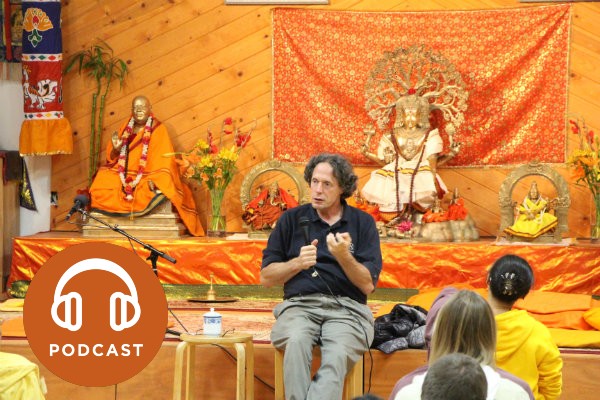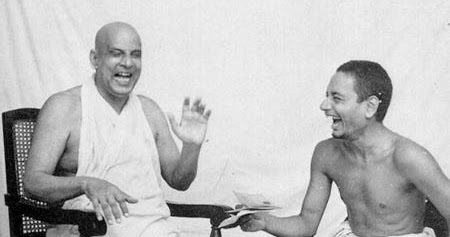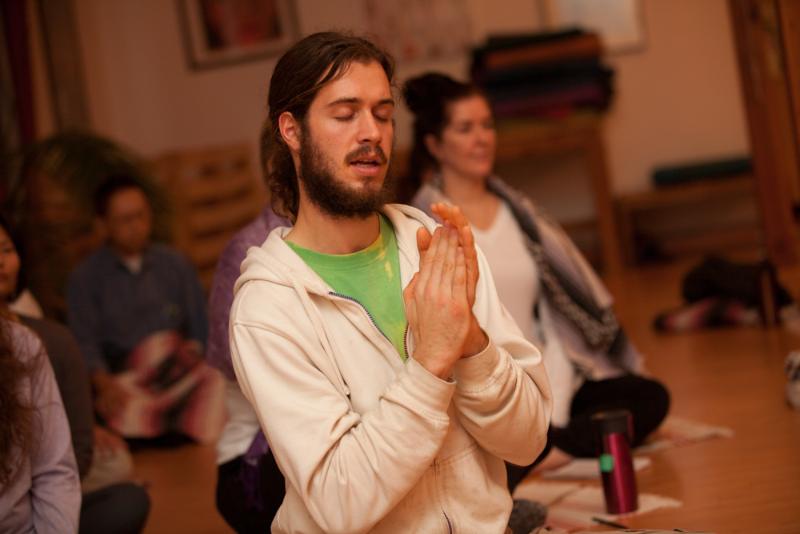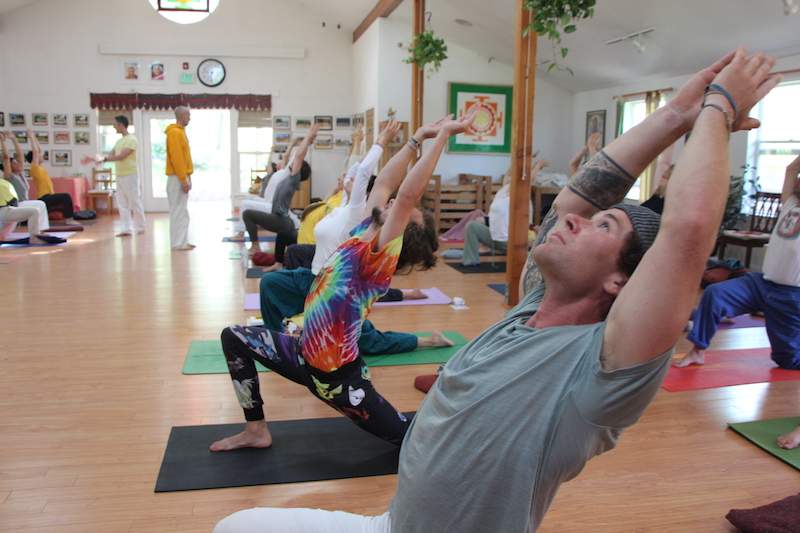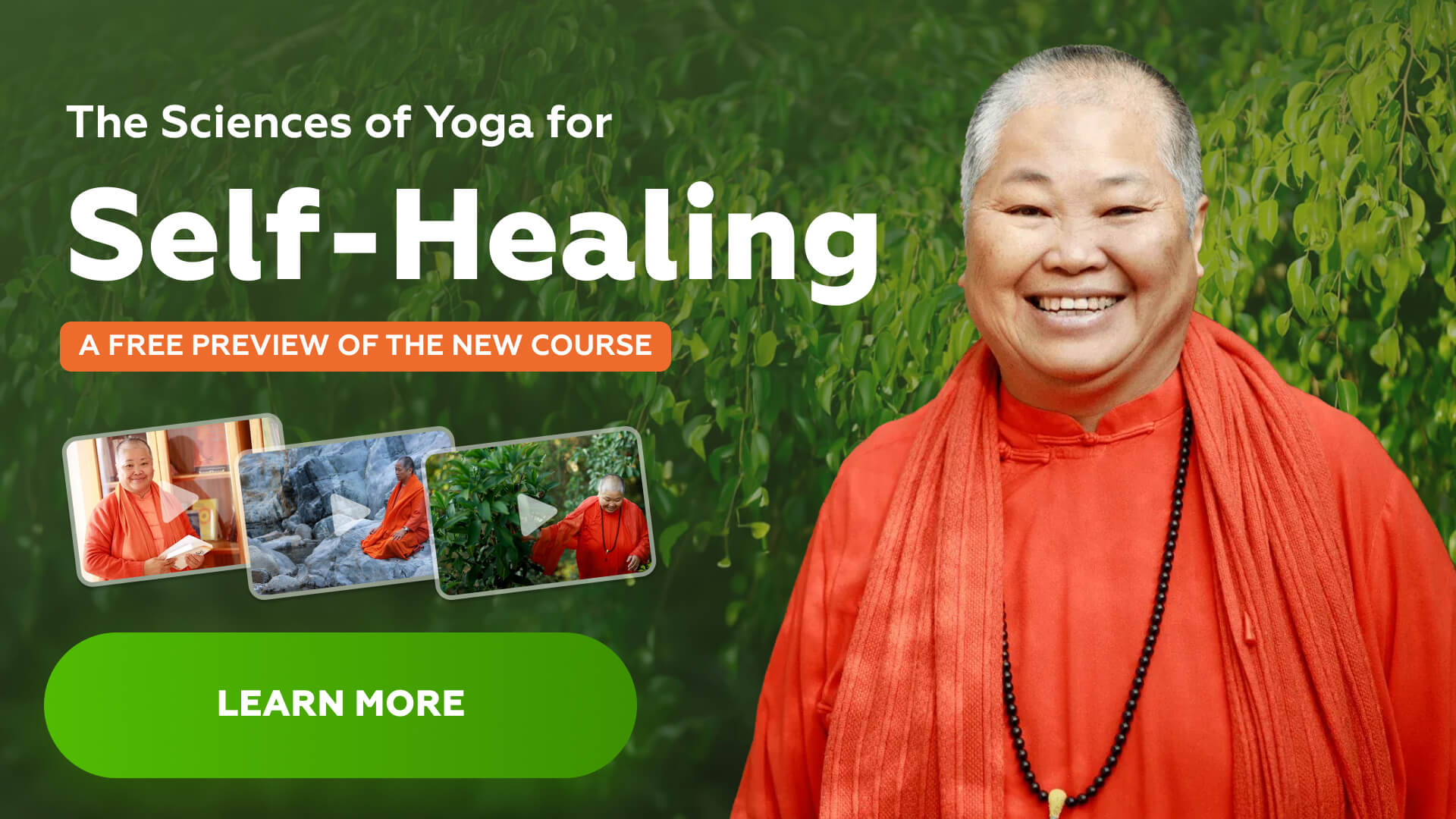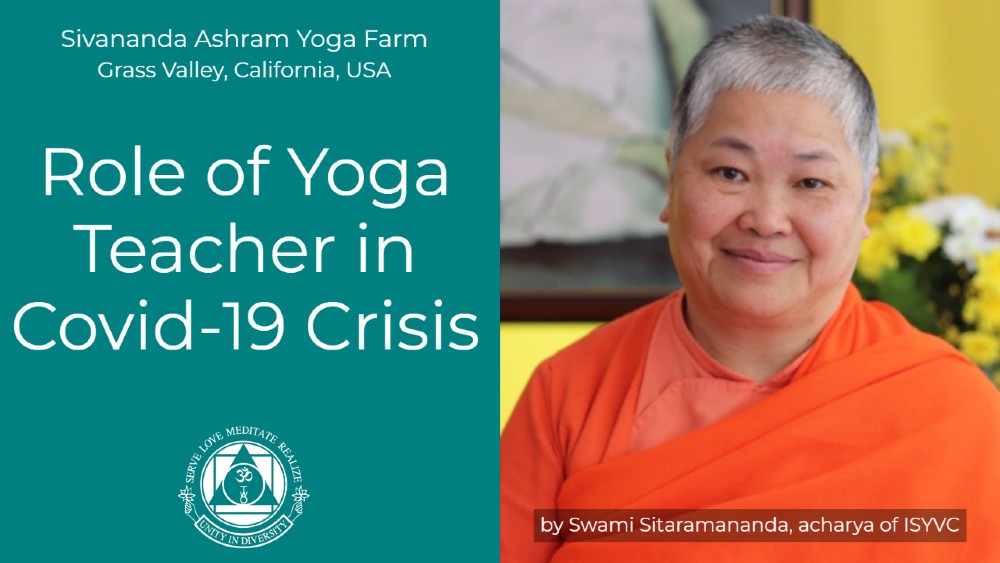
Role of Yoga Teacher in Time of COVID-19
Zoom talk by swami Sitaramananda March 13 2020
Yoga teachers as leaders
The important thing here is that we are uniting together as yoga teachers, Sivananda Yoga teachers. We have a mission to be leaders in time of need and to help people. Which way we can help people is the topic of today. So I hope that you have seen my video and my article. If you have not, please do read it, “self-quarantine or yogic turning inward: how to live with yourself and be happy and healthy”. There is an article about this and it’s been also translated. So in this article there’s already a lot of teaching that is there that you need to communicate with people in your own way.
If you have difficulty communicating with people, then please write to me so that I can explain in a few words what to say and do. For example, if you want to help people convert from fear to self-confidence and faith, you can write to me. The idea is as a yoga teacher you need to feel that you have a responsibility. Sometimes we sit in our corner and we do not really know what to do. The meeting is for that reason, for you to know what you can do.
Thought Power: Time to Spread positive thoughts
The first thing you need to know is that this is a pandemic, but also this is a situation that touches the whole world, and it changes the vibration of the whole world. The whole world is in a panic, in the worrying and questioning mode. It is very important that yogic teaching is known at this time so people will turn from negative thoughts to positive thoughts and know the cumulative action of thoughts. This is what the yoga teacher needs to know, that his or her thinking is not only relating to him or her, or the people that are in the same room or house with him or her.
The thinking together as a collective consciousness, the positive thinking, affects the whole world. Now more than ever we need to be aware of that. We need to be aware that our positive thinking or positive talk affects the world and the way we can help the world to heal and to uplift their consciousness is to more consciously practice our sadhana or yoga. It is so important that you see everything collapsing, changing and the whole world is in lockdown. What that means is people will stay at home and they have a lot of time, things stop, what are all of these people going to do?
This is a moment of transition, a moment of choice, either we are going to be depressed and you will go down with everybody or we are going to rise up. That is why the teachers need to play a leading role.
Raise vibrations with mantras
Most importantly what a yoga teacher needs is to know that his / her thoughts are important. It is very important that you raise your thought vibration by continuing to do your practice. Even though you might think that you are alone in your house doing your practice, you need to do it for the sake of the world. When you do your practice, yoga and meditation, it is not only improving your life but also improving the vibration of the whole world.
So the easiest way to increase your vibration and help the world is repeating Mantras. Those who have been Sivananda yoga teachers know what is a Mantra. There are a few Mantras that you can do, now more than ever, and gather people together to repeat the Mantras because of the collective effect. It’s like adding the energy together and you know that, when you add energy, you don’t just add energy to your country but you add energy to the whole world.
We need to create this positive vibration to balance out all the negative vibration. It is a question of knowledge, not just of blind faith. That means that you know that vibration or thought or Mantra thoughts have effect. You need to repeat a few Mantras and teach people to repeat Mantras as well. Sit together to repeat Mantras. It helps them to have a strong mind, but also it is radiating out.
Good mantras to use in this time
Take the mantra “Om Namo Narayanaya”. With your heart, you send the Mantra out. You know that it helps people to bring them to peace, to calm. The Mantra of Lord Shiva can remove poison, protects you and brings you to high consciousness: “Om Namah Sivaya!” You can record this Mantra and play so people can hear all day long and they can learn also how to pronounce it correctly. The next mantra is a mantra of protection and strength. Goddess Durga is very powerful and she can calm down all fears and all delusions. People are completely crazy and you let them hear this mantra and also not only hearing but seeing the picture.
I have seen many times people with panic attacks. I made them repeat the mantra of Durga and I made them see the picture of Goddess Durga, and it calmed them down. Goddess Durga is very powerful because she can fight with all the demons and the negative forces within your self and outside of your self. The mantra is like this: “Om Sri Durgayai Namah”. Swami Vishnudevananda allowed us to use the strong form of the mantra of Durga with the bija mantra “Dum”. You repeat it like this “Om Dum Durgayai Namah!” Please record this mantra and give it to people to listen and broadcast it.
Now is the time for us to broadcast mantras. Usually we don’t broadcast mantras because people need to be initiated into a Mantra, but now in this time of need, you can work on the mantra “Om Namo Narayanaya”, which is the mantra that Swami Vishnudevananda decided to broadcast a long time ago to help the world. The Mantra “Om Namah Sivaya” is very good because of the virus. The Mantra “Om Sri Durgayai Namaha” or “Om Dum Durgayai Namaha” is excellent because the world is in panic mode.
Mantra for healing
There is another mantra that you can use, record, broadcast and play which is the Mahamrityunjaya Mantra, an excellent mantra for healing and for liberation. If you know people that are sick or very upset mentally because they lost their loved ones, the people that have died, or they are afraid of sickness, you can use this Mantra “Om Tryambakam Yajamahe Sugandhim Pushthivardhanam. Urvaarukamiva Bandhanaan Mrityormuksheeya Maamritaat”.
Please record this mantra and play if you have in your household and your community people that are very anxious. The best thing is to record this mantra and play it at low volume all the time, 24 hours, so they can hear it. Even though they might not understand it but it brings peace to their mind. For the people that just died or they’re on the sick bed, the best thing is to play mantras for them. Every yoga teacher needs to use his / her consciousness. You cannot really repeat the Mantra with only your lips, but rather you have to repeat the mantra with your heart, because consciousness or God is dwelling in your own heart.
Chant mantras with heart and consciousness
It is now the time for you to connect to your heart. When you want to send the mantra to somebody, in order for you the assure the healing power, physical healing and mental healing and also spiritual healing, then you need to do it with your own consciousness and with your heart addressing to the community or to the country or to the person that is in need. Everything really happens in the psychic world – the spiritual world. As a yoga teacher, this is the best time for you to apply.
You need to focus your mind and it’s like a prayer so you can deliver these masses of energy. Basically you have to imagine like this, that you are delivering masses of energy to an area of the world. You don’t need to run there and bring some water and some supplies but you are using this very powerful method of sending positive energy. In the psychic world, everyone receives it.
They might be confused at that time because their senses and their mind are switching their consciousness to another level but in between there will be times when they will be calm and they will be praying then they will receive your prayers. That’s the first action that all yoga teachers need to do, to spread positivity, by Mantra and also please read my article on how there’s a connection between Prana and thought.
Connection between Prana, Thought and Immunity
The more that you do things to increase prana, the more that you are strong and your immune system will be strong to prevent disease. You need to explain that to your students and to your family, the link between Prana and thought. Prana is that which you can find in nature. There will be a talk later about how you can get prana in nature, so you need to explain to them the link between prana, thoughts, emotions and immunity.
The best thing to prevent the world from being sick is to increase immunity, which is the fighting mechanism that nature has given us in order for us to prevent diseases. The prana needs to be high, so you need to increase the prana by absorbing the prana from nature by having a proper lifestyle, eating the right food and also by not spending the prana through negative thinking, worries and actions that are mindless.
Decrease expenditure of Prana through negative thinking
Train your mind. Concentrate your mind, doing mindfulness, mindful actions, the more the prana will be high, the more that you prevent disease, and you will have high immunity. Increase the prana intake from nature, decrease the lost a prana through the senses and through your thoughts, your worries and your negative emotions.
It is a very simple mathematic formula: increase prana, decrease energy waste. We will talk more in detail how you can lose prana and how you can increase prana.
- increase the spreading of positive energy by mantra and positive thoughts.
- increase prana, decrease the expenditure of prana through worries and negative thoughts and through too much information that you cannot digest. When you get too much information that you cannot digest, automatically you would be stressed. Gather the information that you can digest. It’s like food. If you eat too much, you cannot digest then you have toxins. If you eat the food that is not fitting to you, then you also have toxins. You need to do that.
Comforting people, be humble, learn to listen
The other thing that you need to keep in mind is that, in this time people need comfort. Not merely calmness but they need a comforting kind of presence and comforting words. Of course you cannot meet each other like before, you are in quarantine but you can call people on the phone and talk. You know that your presence is important. Sometimes you have some kind of feeling with people and relationship and you don’t want to talk to them, but now it’s a good time that you transcend this kind of limitation that comes from ego, relationship dynamics.
It’s good for you to call people, your friends and relatives, and reach out to your neighbors maybe by phone or email so that you can give comforting words. It’s very easy to give comforting words: “how are you, how are you doing, we are concerned about you, is everything okay, we love you “- these kind of comforting words, and offer empathy. Empathy means we understand why you lost your job, you are at home and you don’t know what to do and you’re depressed, you’re worrying. We understand. Just offer empathy by listening.
People need to be able to talk out their worry, so then at that time you have to just listen but without trying to give an answer because really truly nobody has an answer. Be humble and just try to listen, not only engaging people when you feel that you have an answer. Nobody is having an answer but it’s very helpful to just listen to people. Listen to their voicing out whatever they’re worried and concerned about. That’s enough to help them to feel comforted and to calm down. So know that it is a need to be listened to.
Physical Relaxation
The next point is you need to help people to increase relaxation because this is a time of stress. Know that there are three levels of relaxation. The first level is physical relaxation, because when your mind is tense, your body will be tense. By asana and simple stretch, you let the prana move, you are more relaxed. Savasana or tensing and releasing with attention are a very good exercise.
Maybe your family members or your neighbors are not ready to practice yoga; maybe they still have some kind of prejudice against yoga. It doesn’t matter if you just tell them to lie down and to do some stretch, tense and release, and use their mind to relax their body. It’s called Savasana or physical relaxation, releasing the tension from the body by stretching.
Mental relaxation
The second level of relaxation is mental. What that means you need to understand clearly. When the mind is distracted, it is not calm. When the mind is distracted, the mind has a tendency to worry. It needs to be concentrated. The best thing is that people concentrate on repeating Mantras, singing kirtan, reading books, and studying, but they need to keep their mind focused on something positive.
That is called mental relaxation, when they focus on something positive. It is wrong to think that mental relaxation means your mind is empty. It is wrong because when the mind is empty, it is time to worry. Even though you might not be aware, but thoughts of worry and all kinds of imagination can come into the mind when it is idle. Make sure that people understand that.
Spiritual Relaxation
The third level of relaxation is called spiritual relaxation. Spiritual relaxation is when you know who you are. Most of us are in the dark. This is not only virus crisis, is not only a mental-emotional crisis in the world, but also it is a spiritual crisis because we go on and denying the spirit. We got lost in the consumer world and technological world, and we can go on living our life very rajasic or very externally oriented. We don’t take time to sit down, to think, to study, to introspect, to make wise choices, because we’re being pushed here and there by the senses, by the pressure of advertising, by consumer society.
Now is the time also to spiritually rethink. Spiritual relaxation comes when you have more knowledge of the truth, of this life, when you have more knowledge of yourself, (called self-knowledge). That comes only when you are able to meditate or you have faith. We can talk about faith another time. Try to get people to relax, physically relax, mentally relax and spiritually relax. The more they are calm and positive, they are spiritually relaxed.
Nature helps people to relax
Being in nature is helping people to relax. Maybe you have to be quarantined in your house and you cannot go out but you can look at your plants and take care of your plants or flowers. Look through the window and look at the trees. Anything natural will help you to relax. You have to do it, focus on nature. Yesterday I had people doing an exercise in our advanced TTC class here, an exercise of contemplating nature. Nobody has to go anywhere.
Actually we sat in one place and we just looked at the tree and we looked at the water in the pond, looked at the dog that is passing. We were just contemplating. By being still, learning how to contemplate, everyone experiences a state of calmness, and not just calmness, but a state of joy and unity. This is exactly what we mean when we talk about spiritual relaxation. There are a lot of techniques of yoga that can bring you to that state. We will have a subsequent other kind of teaching so you can make use of all these. Yoga is the wealth of information that you can apply.
The more you apply and the more you see that it works, the more that it encourages you to use it more. Before yoga was regarded as marginal, but now you can see the world is collapsing the way it is, so now is the time for yoga and yoga teachers to bring the secret techniques and methods out and serve the world. There’s no time to lose. This is the time. I talked about relaxation and you need to explain to people that the way they can take care of their fear and anxiety is through increasing relaxation, physically, mentally and spiritually.
Yoga for overcoming anxiety
Now I just give to the yoga teacher a few tips. Actually we study all this in the yoga health education course that is very handy now because we train people to become a health educators, basically in a time of disease, what to do. Here are a few pointers. How do you teach yoga for overcoming anxiety? The first point is that you need to help people to improve the breath, body and mind awareness. Improve breath, body and mind awareness with rhythmical breathing. Just breathe with the diaphragm to get more oxygen, but also use rhythmical breathing, and then it will help.
When you do asana, make sure that people coordinate their breath with their movement and do pranayama. People are afraid sometime to breathe because they are afraid of bringing in the virus. It’s a kind of wrong thinking because it creates more tension. Unless you are already a yogi that you can hold your breath and survive but you are not an advanced yogi so you need to breathe.
Now the best thing is to find nature to practice breathing. You might not be able to go out in the street but you can open your window. You need to ventilate your room and your house. Don’t just close the windows. You need to sit near to the window and you need to breathe. Do pranayama. In general for yoga teachers, you need to know that now is not the time to do intense variations, intense yoga asanas. It’s the time to do gentle yoga to slow down so that you allow more mindfulness, more awareness in your breathing and in your movement. It will counteract the fear and anxiety. You need to do restorative yoga.
If you don’t know what is restorative yoga then you can learn. Basically it is be in very relaxing postures and put some kind of props like blankets and pillows on different parts of your body, on your chest primarily, but also on different parts of your body. It feels like weighed down and comforted. The focus is on mindfulness, awareness, slowing down and be comforted.
Asanas for stress resilience
The second point is to increase the prana, which I said already, by moving the body in order for the prana to move. If you feel that you are stuck and if you feel that you are panicking, then the prana is blocked. At that time your thought goes down more. You need to just keep moving, but in the yoga postures in order to move the prana and to balance the flow of prana.
It is very important at this time because it will help you for your stress resilience. People will increase in their capacity to deal with stress if the prana is balanced. Simple moving of the body, stretching but moving the body in the way of yoga, right and left, backward and forward, in a balanced manner with awareness. At that time the mind will be balanced and you increase your stress resilience.
Improve Mental-Emotional Balance
The third point is to improve the mental-emotional balance. The mental and emotional balance is most effectively accomplished by regulating the breath. If you feel tension, you need to learn to exhale, calmly and as slow as possible, so it releases the tension. Let’s say you are talking to the neighbor and the neighbor is panicking, you can say on the phone to the neighbor: “OK, calm down now, just exhale slowly. Inhale and exhale to the count of six. Inhale and exhale to the count of ten.
Go very slowly and they will calm down. Then the breath needs to go with the movement and the concentration of the mind. The awareness and the concentration need to be there. People cannot do yoga when they are stressed. Why? Because their mind is obsessed with something external and they cannot do yoga. At that time, you tell them to lie down, to stretch, to breathe, and then to concentrate on the breath.
Learn Ayurveda: Increase Ojas Shakti to avoid burnt out
The forth point is that for yoga teachers you need to know that you get burned out and the virus can attack you. One Ayurvedic teacher stated the virus is a pitta disease, which means too much heat in your body. That’s why more relaxation is important. And if you have too much heat and too much anger and too much thinking and too much stress, what you are doing is burning out your ojas, which means the helpful energy to sustain your life. So you are burned out.
What you need to do is to increase the ojas shakti, which means the power of sustenance of you own body that would bring you contentment, gratitude and the sense of relaxation. The key is increase ojas. This is the subtle energy that is taught by Ayurveda. This is a good time to learn Ayurveda and apply the Ayurvedic principle in your diet and your lifestyle to increase ojas, by sleeping well. When you see people that are anxious, they cannot sleep well. You need to apply some warm oil on your body, on your head. You can use warm sesame oil. Heat it up and anything warm, even warm water can be put on the body.
With warm water, you can rub your body. It is okay if you don’t have oil, but anything warm. You can eat properly. When you are stressed, you are going to do nervous eating. You are at home and you have the canned food that you have stored. You don’t know what to do, so you eat the canned food and sugar so it calms you down artificially. This is the worst thing to do. You need to eat very nutritious food, simple food. The essence of the food will feed you, feed the ojas and it helps you to calm down. If you have ghee, you can take one or two spoons of ghee in your food, and then you will be nourished.
Almond drink is also very good for increasing ojas. You need to have a positive feeling and connection to the Divine. That will also give you the direct connection to the source of life, and that will sustain you as well and increase your ojas Shakti. In this time of virus threat, you need to increase your ojas Shakti, which means increasing your quality of life, and not to destroy your life by wrong habits. It’s a time to be much more careful of what you eat, think and feel.
Increase the sense of safety
So now the fifth point we have already talked about. It is to create the sense of security, of warmth, of quiet and of support so that people feel safe. Okay, the key word is feeling safe. To let go of the worries and the defense mechanism because if you feel worried and your fight-or-flight response is increased, then your defense mechanism will wear you out.
So it is important that you relax, that you activate your parasympathetic nervous system by many different means, yoga asana in a conscious manner, rhythmical breath, all this is helping or increasing your parasympathetic nervous system activation and also the faith that I talked about. So use the right brain, increase the faith. If you have some kind of spiritual practice you need to do it now. Do not waste your time in worry but use your time in prayer. Decrease the defense mechanism in the mind.
Increase the detachment attitude
The sixth point is what I talked about a little bit already, the relaxation, but I add on now you need to change your attitude towards life. The attitude before we have is the attitude of being passionate about life, passionate about enjoyment of the senses, rajasic attitude, running here there so your life feels like more meaningful because you are experiencing everything and you are enjoying everything. So that is called rajasic kind of activity. And you need to decrease these kinds of rajasic activity and you need to increase the detachment attitude that means a meditative contemplative attitude towards life.
You step back and then you find the fullness within yourself and you detach about what is going on. We must think about this more and there is more teaching that needs to be involved in this matter because even though it is not that easy but basically I just give you a taste of this. You need to be detached towards your actions and the result of action, that means your work, your money and your life. Be detached from it. If you attach to it then you have more worry, so try to be detached from the result of your effort and the result of your action. I know it is difficult but still that is the way to go.
Either you worry about it and you cannot do anything about it, and then you will make yourself worse and then you get disease because your immune system is low or you can just basically take the stand of being detached and to be in the present. Then you will be more recharging yourself and things are not that bad. So basically change your attitude towards your whole life should be more detached be more centered.
The best person who can supports you is your Own Self
Point number 7 is you need to experience the connection with your own self and to others so the sense of connection is very important for mental health. People talk about social distancing; everyone needs to stay away from each other, not moving. But then people don’t know what to do. So they stay home and they are depressed. They miss their friends. They miss their social activities, so they are depressed, angry and worried. This will make things worse. You might help in not spreading the virus, but you are increasing the spreading of the negative virus of the mind.
When people are worrying and they send the negative thoughts out to the atmosphere. You need to be aware of that. You need to help people feel the connection to their own Self. These yoga techniques of asana, pranayama and meditation are helping at this time for people to feel the connection with their own Self. We are having the bad habit to always think of something external or somebody external to ourselves is supporting ourselves. And these relationships are very essential for our well being. Fine and good. You have your supportive network, your friends and people that you trust and love.
This is very good. I don’t say anything against this. But what I am saying is that you need to have your own support system in your own Self. And you need to turn you mind inward in order for you to find that support system within your own Self. And that would help you because even if you have your loved ones, they cannot be there with you 24 hours 7 days a week. They cannot be there for you all the time. And then you feel let down, worried and anxious when they are not there. So the best person who can support you is yourself. Turn inward, feel the strength from within.
Do Self Affirmation
Do Self-affirmation. Let’s say you never think about this kind of thought before. And now it is the time for you to do Self-affirmation. Right down the sentence and repeat yourself many times. “I am content and happy with myself.” You say something like this. Day by day, everything is improving, everything is better in every way. So say things like that: “I am happy with the present moment”. Do Self-affirmation, something that you feel is good.
The positive thought that helps you, and at that time you keep repeating that thought, because that thought will gain more momentum and more power in the psychic world and then at that time it helps you because when you are panicking, this thought will come up to the surface of the mind and will help you. You have to do Self-affirmation as a habit. Create a gratitude list. So your heart keeps opening, your worries and negative emotions, anger and frustration come only when you have your heart closed. Your heart becomes limited and closed, then you have the tendency to blame and to be negative.
This is not the time to blame, to be negative, you should not blame anybody, and try to cooperate and not blaming. Everyone is trying to do their best. If you blame people to lie, to cheat, to not do the right thing, you are sending more negativity in the world. Try to send positive energy. Try to focus on the positive, not on the negative and the blaming.
Teach a gentler Yoga class
So now the last point, in the yoga class, when you teach the yoga class, I said already, teach a gentler yoga class. It is encouraging and calming. That is the best that you can do. Of course in the time of social distancing and we advise that yoga teachers should not correct the students. You can teach people online. You can use Zoom, video conferencing, in order to teach people online. But only if you have people at a room in your house, it is advisable that you have them sit at a separate distance from each other and you are not touching them, correcting them.
So with your voice, that is what you can do. You can use the voice, the verbal cue with people and correct them. It is very important for yoga teachers to remember is to wash your hands with soap in the beginning and at the end of the class. If you do teach people, everyone needs to wash their hands with soap for at least 20 seconds, with awareness, as much as you can. That is the only way right now to not to spread the virus. We said a few tips for yoga teachers already.
Restoring Faith, faith gives you stronger immunity
The last point that I have before you ask questions is restoring faith. The idea is the virus comes from nature, and then we become suspicious of nature. We become afraid of nature that can be also, you can say, nature is God or Goddess, is the universal presence around us we call nature. So we need to reconnect with Mother Nature instead of being fearful and blameful of Mother Nature. You need to recognize that you have mistreated Mother Nature, not be as aware of her presence as you could.
You maybe have acted like a spoiled kid and think that mother will always be there for you. And when mother is upset, and she spanks you, you get angry. But you need not be angry with Mother Nature. That is my point. You need to rely on her, even though something is manifesting which you perceive to be negative and it comes out of the blue and it is mysterious, and you don’t understand but still you need to have you heart open toward Mother Nature. You know that she is there to take care of you, that she loves you and she gives you everything that you need. But stop acting like a spoiled kid and remember her. So restore your faith in nature. Those who have faith toward your particular god, prophet, religion, name and form of your faith, it is very good because you have your faith. In time of need, we usually turn toward our faith. We learn how to pray.
So what I am saying is you need to restore your faith. It is not the time to doubt even though the tendency is more to doubt at this time, to be anxious and doubting. It is the opposite of what you need to do. And you need to reconnect and to be appreciative and to pray. Why? Because faith keeps you going. In time you want to control but you cannot control. You want to understand but you cannot understand. At that time, faith is what you’ve got. Faith keeps you going and faith gives you stronger immunity. Faith gives you strength. This is the time to relate to our faith, not the time of doubt. Of course you have to do the thing that is needed. There are practical things that you need to do to not spread the virus, not to be sick yourself, increase your immune system as we talked about ealier. But you need to take care of your own spiritual Self, or your God. Try to find the connection with God.
For some of you, it might be not something that you are used to, but it is never too late for you to understand that you are never alone, that you are not in control. It is some intelligence that takes care of things, in a bigger scale than you can currently see. For a yoga teacher, it is very important to have strong faith, because you have to be positive and guide the students.
Vedanta philosophy about the Self and the Not Self
For a Vedanta student, Vedanta is Yoga philosophy, then we talk about the Self, and about the detachment toward the things that are transient and changing, and to discriminate, to know the difference between what is permanent, and that which is changing, which is the Self and that which is the not-Self. You need to have some basic education in Vedanta philosophy, which is Yoga philosophy in order for you to understand how to do this.
But in general you need to remember that there is some presence within you, consciousness within you that is there, no matter what. You need to tune to that. That consciousness can be seen outside as hands of God or the Divine, or can be seen inside as your own inner deeper presence.
Yoga Teachers and Health Educators need to be patient
That’s enough talk and we need to keep rehearsing because one time you hear, one time you practice is not enough. I’ve been doing this for almost 40 years basically, just rehearsing and rehearsing, hearing it again and again. For yoga teachers and health educators, just know that it is not one time that you need to say to your student to calm down. You need to be very patient, to repeat again and again.
Be available to the students and people because people hearing one time is not enough. Your presence needs to be there steady and constant, and you need to be repeating. Don’t be afraid of repeating yourself. It is not the question of information here but it is the question of self-transformation and to help people to go more deeply within themselves.
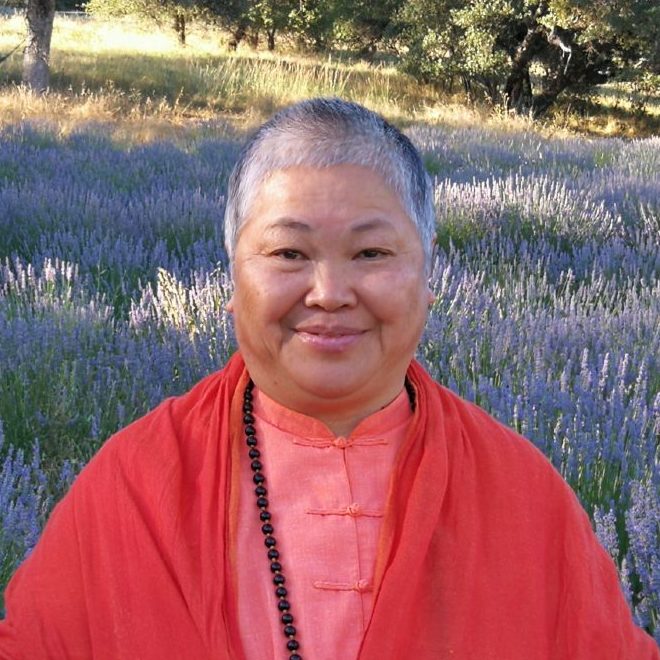
Swami Sitaramananda is a senior acharya of the International Sivananda Yoga Vedanta Centers and is director of the Sivananda Ashram Vedanta Yoga Farm, California and the Sivananda Yoga Resort and Training Center, Vietnam. She is acharya of China, Taiwan, and Japan as well. Swamiji is the organizer and teacher of the Sivananda Yoga Health Educator Training (SYHET) program, an 800-hour program on yoga therapy, accredited by the International Association of Yoga Therapists (IAYT).
Swami Sitaramananda is the author of “Essentials of Yoga Practice and Philosophy” (translated in Chinese, Japanese, Vietnamese, and Russian), “Positive Thinking Manual”, “Karma Yoga Manual”, “Meditation Manual”, “Swamiji Said, a collection of teachings by Swami Vishnu” in His Own Words. She is responsible for the Vietnamese translation of “Completed Illustrated Book of Yoga” (CIBY) and “Meditation & Mantras” by Swami Vishnu. Many of her video & audio lectures on Yoga life, philosophy, and psychology as well as articles and webinars can be found on this website.
Swami Sita is an ardent supporter of the integration of the Vedic sciences such as Vastu, Jyotish, Ayurveda, Yoga and Vedanta. She is an international teacher of the Sivananda Yoga Teachers’ Training Courses and Advanced Yoga teachers’ Training courses, as well as Meditation and Vedanta & Silence Courses both in Sivananda Ashrams in Vietnam and in Grass Valley, CA.




